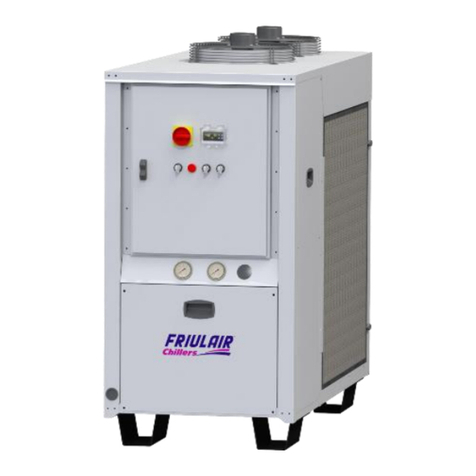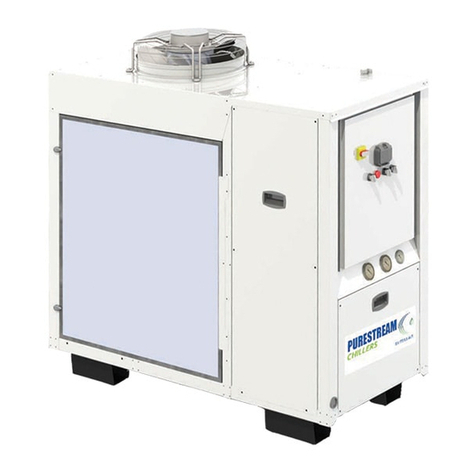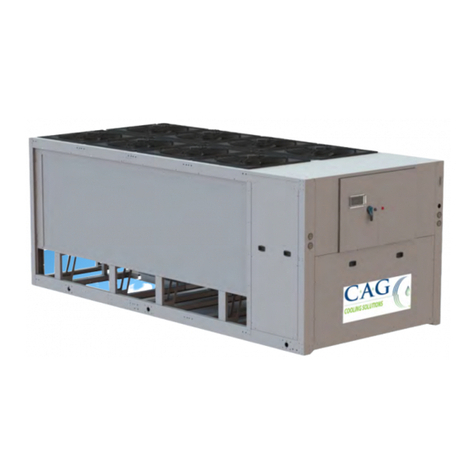
SUMMARY
1Safety Rules ............................................................................................................. 1
1.1 Definitions of the symbols used ........................................................................................ 1
1.2 Warnings .......................................................................................................................... 2
1.3 Proper use of the chiller .................................................................................................... 2
1.4 Instructions for using equipment under pressure conforming to PED Directive 2014/68/EU
3
2Operation And Main Components .......................................................................... 4
2.1 Refrigerant circuit .............................................................................................................. 4
2.2 Water circuit ...................................................................................................................... 4
2.3 Fan ................................................................................................................................... 4
2.4 Condensation control ........................................................................................................ 4
2.5 Control of the water temperature....................................................................................... 5
2.6 Protecting the integrity of the machine .............................................................................. 5
2.7 QBS units: identification of the main components ............................................................. 5
2.8 Spare parts ....................................................................................................................... 6
3Installation ................................................................................................................ 7
3.1 Transport .......................................................................................................................... 7
3.2 Storage ............................................................................................................................. 7
3.3 Place of installation ........................................................................................................... 7
3.3.1 Installation spaces......................................................................................................................................... 8
3.4 Water connections ............................................................................................................ 8
3.4.1 Recommended water system ....................................................................................................................... 9
3.4.2 Use of ethylene glycol as a winter anti-freeze............................................................................................ 10
3.4.3 Charging the water circuit........................................................................................................................... 10
3.5 Electrical connections ..................................................................................................... 11
4Preliminary Checks And Start-Up ......................................................................... 12
4.1 Preliminary checks and preparation for the first start-up ................................................. 12
4.2 Startup ............................................................................................................................ 12
4.3 Start-up under critical conditions ..................................................................................... 12
5Electronic Controller – QBS standard .................................................................. 13
5.1 Main functions of the electronic controller buttons and meanings of the icons ................ 13
5.2 Turning on and off ........................................................................................................... 14
5.3 Controlling water temperature ......................................................................................... 14
5.4 Changing the set point .................................................................................................... 14
5.5 Temperature display as detected by the probes .............................................................. 14
5.6 Locking and unlocking the keyboard ............................................................................... 15
5.7 Compressor operation hours ........................................................................................... 15
5.8 Setting the configuration parameters ............................................................................. 15
6Autoadaptive Controller – QBS with EAA option ................................................ 16
6.1 Main functions of the electronic controller buttons and meanings of the icons ................ 16
6.2 Turning on and off ........................................................................................................... 16
6.3 Controlling water temperature – Standard setting ........................................................... 17
6.4 Changing the set point .................................................................................................... 17
6.5 Showing the temperature read by probe 1 (ambient temperature) .................................. 17
6.6 Showing the temperature read by probe 2 (outlet water temperature) ............................. 17
6.7 Locking/Unlocking the keyboard ..................................................................................... 18
6.8 Alarms ............................................................................................................................ 18
6.9 Setting configuration parameters .................................................................................... 18
6.10 Table of standard parameters configuration .................................................................... 19































